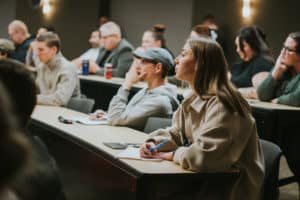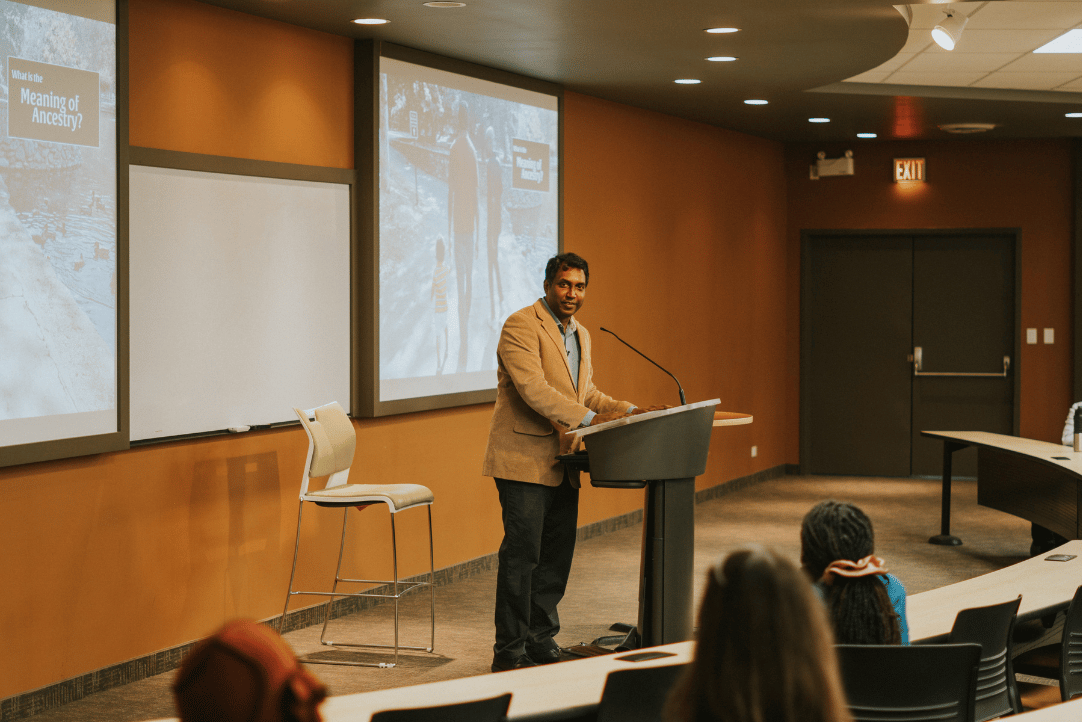OTTERBURNE, MB – Last month, on October 25th, more than 80 people attended a Guest Lecture with Dr. Joshua Swamidass on our Providence campus in Otterburne. Swamidass is a physician, scientist and author. He holds both a MD and PhD, teaching at the Washington University in St. Louis in the area of Laboratory and Genomic Medicine.
He leads a computational biology group in the Institute for Informatics, has published more than 80 articles in peer-reviewed journals and serves as science advisor for the American Association for the Advancement of Science (AAAS) project. Providence was able to bring Swamidass to Manitoba as part of the Science for Seminaries seed grant that was received last year. This was the first talk that Swamidass has given in Canada.
As a devoted Christian and scientist, Swamidass regularly tackles topics at the intersection of science and faith. In his most recent book called The Genealogical Adam and Eve: The Surprising Science of Universal Ancestry (IVP Academic, 2019), he tests a scientific hypothesis which explores the traditional, scriptural account about the origins of Adam and Eve taking place alongside of the scientific theory of evolution.
“I’ve gotten caught up with some larger questions, asking, ‘What is the meaning of ancestry?’ Even adopted children wonder about their birth parents. As human beings, we have an awareness of the long ancestry we come out of and it’s important to our identity. This is the reason theologians care about it,” explained Swamidass.
“A lot of the confusion, which has risen in recent decades, has been the mix up between how scripture talks about ancestry and how scientists by default think about it.”
Scientists tend to think about ancestry in terms of genetics by studying changes in the human genome across time, while Scripture is interested in how people can trace their origins across generations. These two different ways of thinking about ancestry could be presenting us with different aspects of one story.
“Our world is consumed with questions about DNA and genetics, and that’s how we tend to approach things in our modern concepts. It’s important to understand that DNA is a very recent idea,” said Swamidass in his recent lecture. “It’s about 100 years ago that DNA was discovered. DNA structure was figured out 60 to 70 years ago. The human genome was only sequenced 20 years ago.”
When the Bible was written, there was no knowledge about DNA. They only had a sense of inheritance. We inherit a great deal from our ancestors including language, culture, beliefs and conflicts. Our ancestry helps us understand who we are and where we come from.
We have to keep in mind that genetics and genealogy are answering different questions. Genetics operates at the level of populations. As a result, the de novo creation of a human couple six to ten thousand years ago would be invisible to modern genetics, existing outside of the field illumined by its light. However, if there were a relatively recently Adam and Eve specially created alongside a previously existing population of humanoid creatures, Swamidass argued that developments in the science of genealogy have shown that they could easily have become the ancestors of every person on Earth by the 1st century A.D. In this way, one would not have to choose between the Bible’s insistence that Adam and Eve were the genealogical ancestors of all humankind and modern science’s insistence that human beings arose through a process of evolution. Both could simultaneously be true, as they are speaking to different facets of the same story. (Swamidass’ hypothesis has the added bonus of answering the perennial Sunday School question of “Where did the children of Adam and Eve find their spouses?”)
Swamidass invited his audience to participate in the conversation and to approach questions with courage, curiosity and empathy as well as with rigorous investigation and honesty. There is a wide, open field of what is possible. Swamidass remarked, “What has been traditionally thought of as a wall is really a door. And if you turn the knob on the door, you enter a whole new world of discovery. Boundaries disappear and adventure begins.”
Providence’s Associate Professor of Theology and Ethics, Dr. Robert Dean, closed the lecture by saying, “The work of Dr. Swamidass has made a seminal contribution that challenges us to think further. A seminal work in science is not just something that breaks new ground but is something that opens up all sorts of interesting areas of conversation and exploration.”
You can learn more by listening to a recording of Dr. Swamidass’ lecture at Providence here, or by visiting peacefulscience.org.




